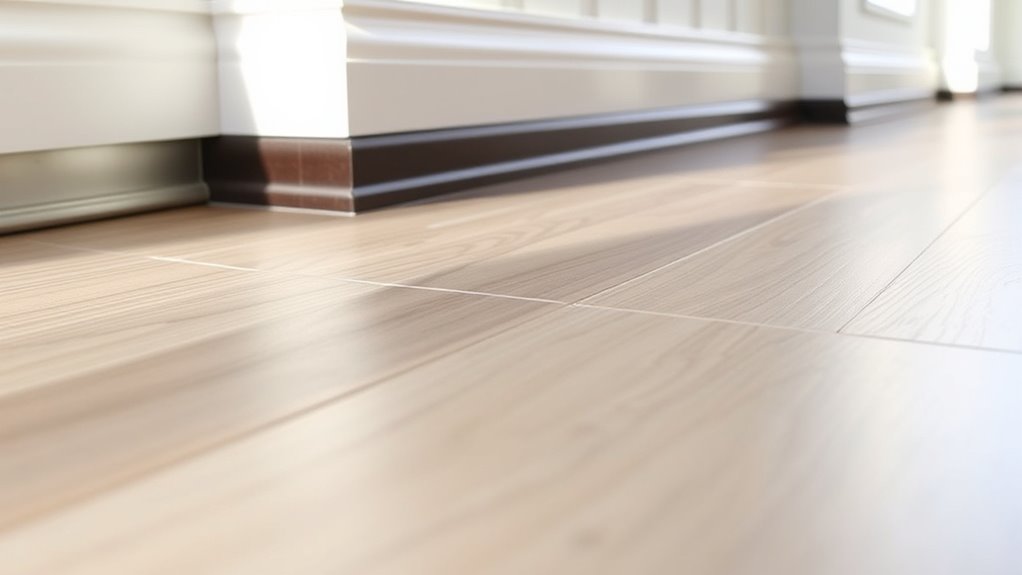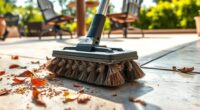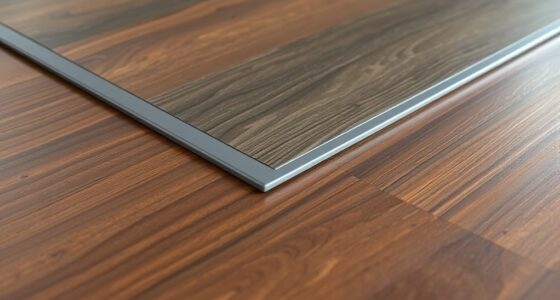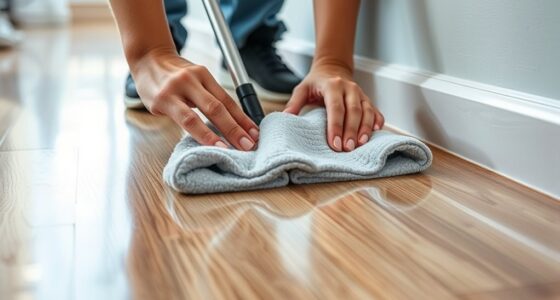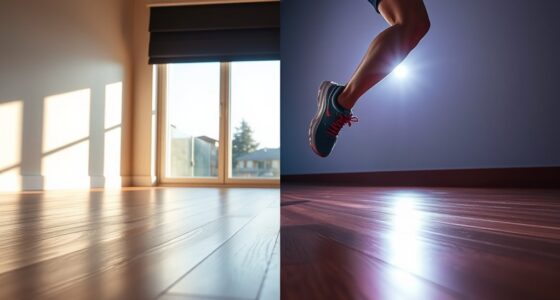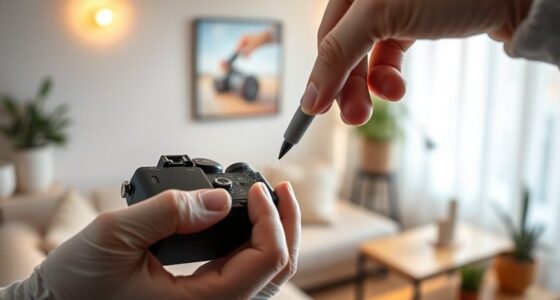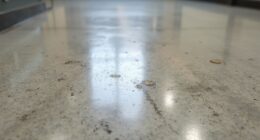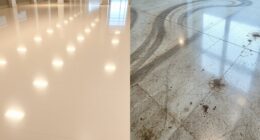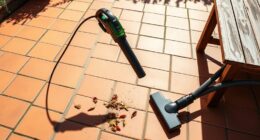To clean edges and baseboards on vinyl plank floors effectively, use soft tools like microfiber cloths, gentle brushes, or microfiber mops. Start with dry dusting to loosen dirt, then gently wipe with a slightly damp cloth to remove stubborn grime. Be careful around corners and crevices, using small brushes or soft toothbrushes for detail work. With these smart passes, you’ll keep your floors spotless and protected—stay with us to learn more about perfecting your cleaning routine.
Key Takeaways
- Use soft brushes and microfiber cloths for gentle dust removal from edges and baseboards.
- Employ small, angled brushes or toothbrushes to clean corners and tight crevices effectively.
- Dampening cloths slightly helps remove stubborn dirt without damaging the vinyl surface.
- Regularly dust and wipe to prevent dirt buildup and maintain a clean, polished appearance.
- Avoid excessive moisture and harsh tools to protect vinyl floors during edge and baseboard cleaning.
Choosing the Right Tools for Edges and Baseboards
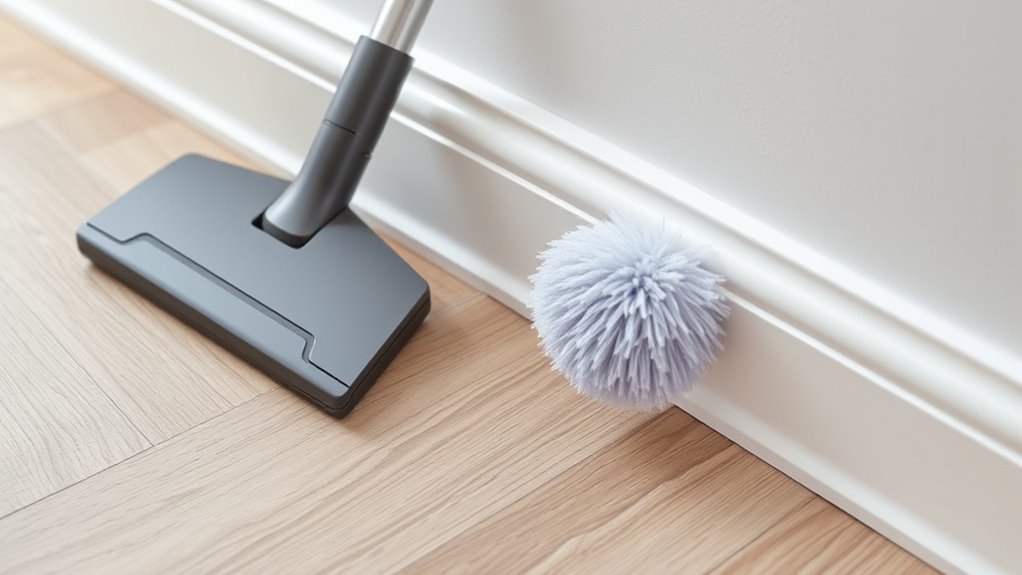
Choosing the right tools is essential for achieving clean, professional-looking edges and baseboards on your vinyl plank floors. Start with a microfiber or soft-bristle brush to loosen dust and debris without scratching the surface. A small, angled brush or detail brush works well for tight corners and along baseboard edges. For larger, flat areas, a microfiber mop or a vacuum with a brush attachment can efficiently pick up debris near edges. Use a putty knife or a plastic scraper for stubborn dirt or to gently lift debris from the edges without damaging the vinyl. Don’t forget to have a damp cloth or sponge handy for quick touch-ups. Selecting these tools ensures your cleaning is thorough, safe, and leaves your floors looking crisp and well-maintained.
Preparing Your Space for Effective Cleaning
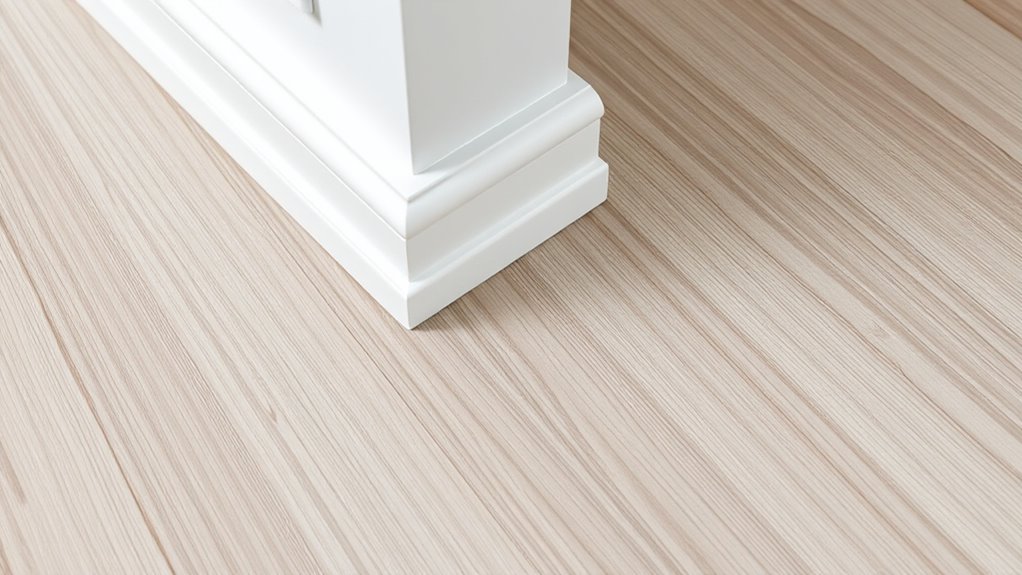
Before you start cleaning, clear the area of furniture and obstacles to give yourself easy access to the edges and baseboards. Next, gather all your cleaning supplies so you’re ready to tackle every spot effectively. This preparation helps guarantee your cleaning session is quick and thorough.
Clear the Area
To guarantee your cleaning is effective, start by clearing the area around the vinyl plank floors. Remove all furniture, rugs, and objects that may obstruct your access. This ensures you can clean thoroughly without missing spots or getting stuck. Clearing the space also prevents accidental damage to delicate items or the flooring itself. Take time to pick up loose items like toys, shoes,, or clutter that could interfere with your cleaning tools. Moving everything out of the way makes sweeping or vacuuming more efficient and helps you reach corners and edges more easily. By creating an open space, you can focus on cleaning every inch of your floor, including tricky edges and baseboards, with precision and ease. Additionally, understanding the importance of contrast ratio can help you evaluate how well your projector displays dark scenes, ensuring a clear and vibrant viewing experience.
Gather Cleaning Supplies
Gather your cleaning supplies before you start to guarantee the job goes smoothly. Having everything ready saves time and prevents interruptions. You’ll want a microfiber cloth or soft sponge, a gentle cleaner suitable for vinyl floors, and a soft-bristled brush or toothbrush for tight corners. Keep a mop or microfiber mop handy for larger areas. If you prefer, use a spray bottle for your cleaning solution to target stubborn spots. Wear gloves if you have sensitive skin, and have a small bucket or spray bottle nearby for rinsing your cloth. Organizing your supplies within easy reach ensures you can move efficiently around the room. Preparing your tools beforehand also minimizes the risk of water damage by ensuring proper cleaning techniques and avoiding excess moisture.
Dry Dusting Techniques for Initial Dirt Removal
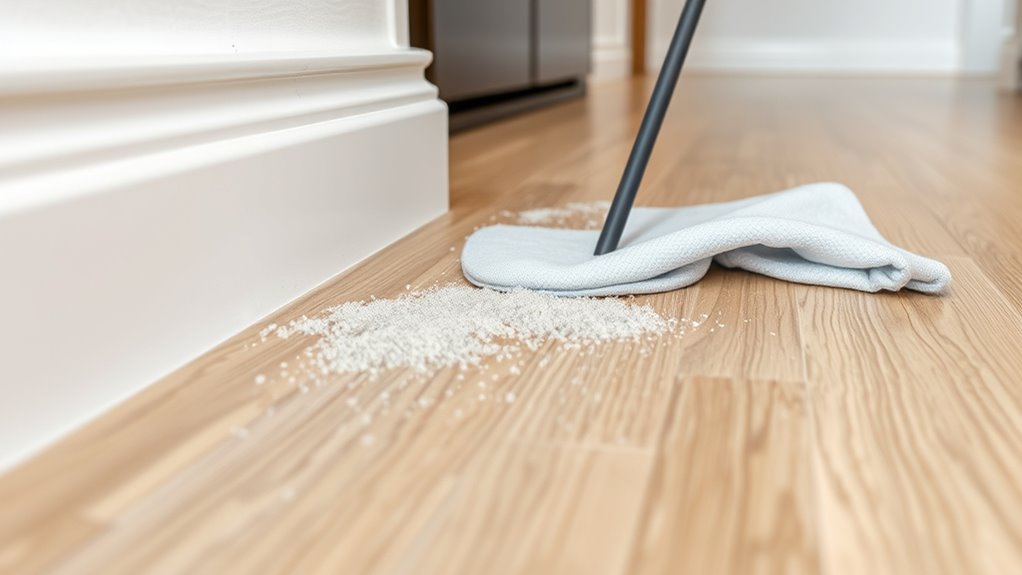
Dry dusting is an effective way to remove loose dirt and debris from edges and baseboards on vinyl plank floors. Start by choosing a soft-bristled brush, a microfiber cloth, or a vacuum with a brush attachment. Gently glide the tool along the baseboards and edges to lift dust and dirt without scratching the surface. For stubborn debris, slightly dampen the cloth or brush with water, but avoid excess moisture that could harm the vinyl. Be thorough but gentle, paying attention to corners and tight spaces. Regular dry dusting prevents dirt buildup, making subsequent cleaning easier. This initial step keeps your floors looking fresh and reduces the need for more intensive cleaning later. Always use light pressure to avoid damaging the vinyl or dislodging baseboard trim. Incorporating proper tuning techniques can also help maintain the longevity of your flooring and furniture.
Using a Microfiber Mop for Gentle Cleaning
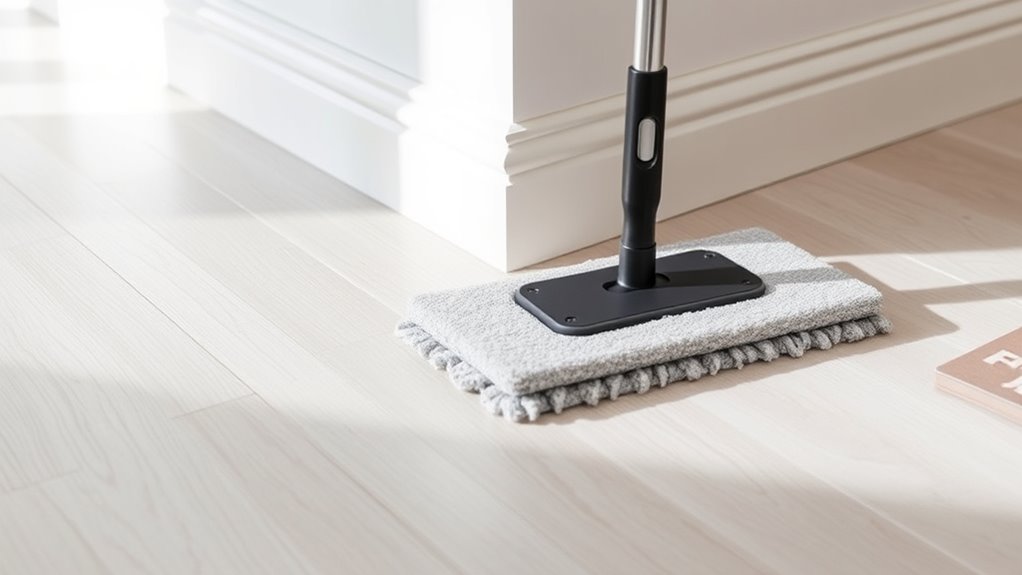
A microfiber mop is perfect for gently cleaning your vinyl plank floors without causing scratches. Its soft fibers lift dirt effectively while avoiding damage to the surface. Using this tool helps keep your floors looking fresh and protected over time. Additionally, microfiber mops can be used with gentle cleaning solutions, ensuring thorough cleaning without compromising your flooring.
Gentle Dirt Removal
To effectively remove dirt from edges and baseboards on vinyl plank floors, a microfiber mop is your best tool for gentle cleaning. Its soft fibers lift dust without scratching or damaging the surface. To maximize effectiveness, consider these steps:
- Lightly dampen the microfiber mop with water or a gentle cleaning solution, avoiding excess moisture.
- Gently glide the mop along the baseboards and edges, following the natural contours.
- Use a light, sweeping motion to lift dirt without pressing hard or forcing debris into the seams.
This method ensures thorough cleaning while preserving your vinyl flooring’s integrity. The microfiber’s fine fibers pick up dust, hair, and dirt easily, leaving your edges and baseboards looking fresh and clean with minimal effort.
Avoiding Floor Damage
Using a microfiber mop for cleaning edges and baseboards helps prevent damage to your vinyl plank floors. Microfiber mops are gentle yet effective at picking up dust, dirt, and debris without scratching or dulling the surface. Unlike harsh brushes or abrasive cleaning tools, microfiber fibers lift particles softly, reducing the risk of gouges or scrapes. When cleaning near edges and baseboards, a microfiber mop allows you to reach tight spaces without applying excessive pressure. Always use a slightly damp mop—avoid soaking it—to prevent excess moisture from seeping into seams or beneath the planks. Regular use of a microfiber mop keeps your floors looking new, minimizes wear, and preserves the integrity of your vinyl over time. This simple step dramatically reduces the chance of accidental damage during routine cleaning.
Applying a Slightly Damp Cloth for Stubborn Dirt

When dealing with stubborn dirt along edges and baseboards, a slightly damp cloth can be highly effective. It helps loosen grime without risking water damage or warping. First, dampen a microfiber cloth with water, then wring out excess moisture so it’s just damp. Next, gently wipe along the baseboards and edges, avoiding excess water that could seep into seams. Using ergonomic tools can make the task easier and more comfortable, especially during extended cleaning sessions.
Here are key tips to keep in mind:
- Use a light touch to prevent damaging the vinyl surface.
- Focus on small sections for better control.
- Rinse and wring the cloth frequently to avoid spreading dirt.
This simple step restores cleanliness without harsh chemicals or abrasive tools, keeping your floors looking fresh.
The Benefits of Using a Detailing Brush
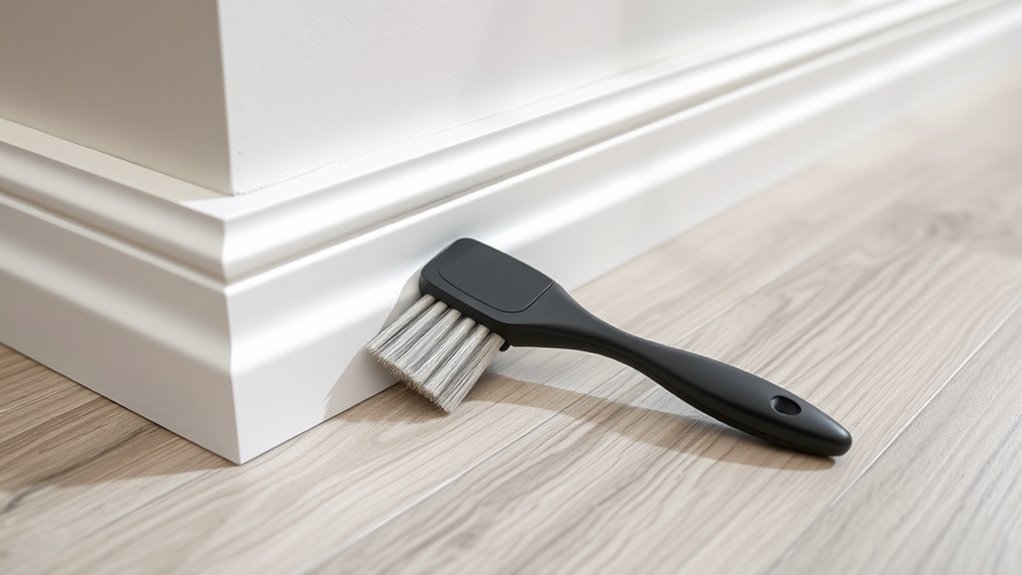
A detailing brush helps you reach tight spaces around baseboards and edges with ease. It allows you to clean precisely without risking damage to your vinyl surface. Plus, it’s gentle enough to keep your floors looking pristine over time. Using a detailing brush can also help remove accumulated dirt and debris that may affect the longevity of your flooring, similar to how ECU tuning optimizes engine performance in vehicles.
Precision in Tight Spaces
Moving through tight spaces between vinyl plank floors and baseboards can be challenging, but a detailing brush makes the task much easier. Its small size and precise bristles let you reach corners and crevices without disturbing nearby surfaces. With a gentle sweep, you remove dust, dirt, and debris that often hide in hard-to-reach spots. Imagine:
- Navigating along the edge where the floor meets the wall without knocking over decor.
- Cleaning dust from narrow gaps between planks and molding.
- Tracing along baseboard corners to eliminate stubborn grime.
- Using self-watering techniques to maintain consistent moisture levels in potted plants and prevent overwatering.
A detailing brush provides the control you need for a thorough clean. It’s perfect for detailed work, ensuring your floors and baseboards look fresh and well-maintained, without any missed spots or damage.
Gentle Surface Care
Using a detailing brush for surface care guarantees you clean your vinyl plank floors gently yet effectively. Its soft bristles reach into corners and along edges without scratching or damaging the surface. This tool is perfect for removing dust, dirt, and debris from tight spots that larger tools can’t access. You can easily maneuver around baseboards, seams, and textured areas, ensuring a thorough clean without harsh scrubbing. The gentle action preserves the finish and integrity of your vinyl floors over time. Plus, a detailing brush allows you to target specific spots that need extra attention, helping maintain a fresh, polished look. Regular use of this small but mighty tool keeps your floors looking their best while preventing unnecessary wear. Proper surface care also extends the lifespan of your floors and maintains their aesthetic appeal.
Best Practices for Cleaning Along Wall Corners

Cleaning along wall corners on vinyl plank floors requires careful attention to avoid damaging the edges or dislodging the baseboards. You want to be gentle but effective. First, use a microfiber cloth or a soft-bristled brush to loosen dust and dirt in tight spaces. Second, opt for a slightly damp cloth—never soaking wet—to wipe along the corners without causing water damage. Third, for stubborn debris, a soft toothbrush can reach into crevices without scratching the surface. Be patient and avoid forcing tools into tight spots, as this can loosen or chip the vinyl. Always work slowly and with gentle pressure. Proper technique ensures your vinyl floors stay pristine and your baseboards remain intact. Additionally, understanding the importance of gentle cleaning techniques helps preserve the longevity of your flooring and baseboards.
How to Safely Remove Dust From Baseboard Crevices

Dust tends to collect deeply in the narrow crevices of your baseboards, making it important to approach removal carefully. To do this safely, start by using a soft brush or a toothbrush to loosen dust without scratching the surface. You can also attach a microfiber cloth to the end of a small, flexible tool like a paintbrush handle or a narrow duster. Gently glide the brush or cloth into the crevices, avoiding excessive pressure. For stubborn dust, lightly dampen the cloth with water or a gentle cleaning solution, then wipe carefully. Always verify your cloth isn’t too wet to prevent moisture damage. Regular, gentle cleaning prevents dust buildup and keeps your baseboards looking fresh without risking damage.
Tips for Maintaining a Spotless Finish
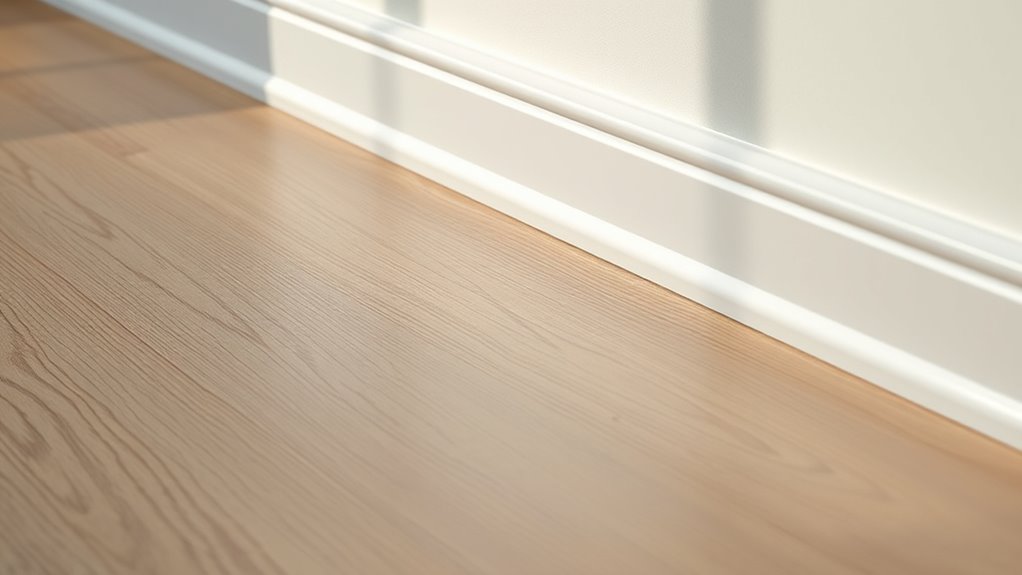
To keep your vinyl plank floors looking pristine, establish a regular cleaning routine that targets dirt and debris before they settle into the surface. Consistent maintenance prevents buildup and keeps your floors shiny. Here are three key tips:
Maintain your vinyl plank floors with regular, gentle cleaning to keep them shiny and spotless.
- Use a microfiber mop or soft cloth to pick up dust and loose dirt daily.
- Clean spills immediately with a damp cloth to prevent staining or warping.
- Avoid harsh chemicals; opt for a gentle cleaning solution diluted with water to preserve the finish.
Routine Cleaning Schedule for Long-lasting Results

Establishing a consistent cleaning schedule is essential for maintaining the beauty and durability of your vinyl plank floors. You should sweep or vacuum at least twice a week to remove dirt, dust, and debris that can cause scratches. Follow up with damp mopping every one to two weeks using a gentle cleaner specifically designed for vinyl floors. Avoid harsh chemicals that can damage the surface or strip the finish. If you notice sticky spots or stains, address them promptly with a soft cloth and mild cleanser. Regular maintenance prevents buildup and keeps your floors looking new longer. Adjust your schedule based on foot traffic—more frequent cleanings may be necessary in busy areas. Staying consistent guarantees your vinyl floors stay protected and beautiful for years to come. Incorporating proper cleaning techniques can further enhance the longevity and appearance of your flooring.
Frequently Asked Questions
Can I Use a Vacuum on Vinyl Plank Floors Without Causing Damage?
Yes, you can use a vacuum on vinyl plank floors without causing damage. Just make sure you use a vacuum with a hard floor setting or a soft brush attachment to prevent scratching. Avoid using beater bars or rotary brushes, as they can scratch or damage the surface. Regularly vacuuming helps remove dirt and debris, keeping your floors looking their best without risking harm.
Are There Any Specific Cleaning Products to Avoid Near Edges and Baseboards?
Did you know that using the wrong cleaning products can damage 60% of vinyl floor edges? You should avoid harsh chemicals like bleach, ammonia, or abrasive cleaners near your baseboards. Stick to pH-neutral solutions or mild soap and water. These gentle cleaners prevent the buildup of residue and protect the edges, ensuring your vinyl floors stay beautiful and durable without risking damage.
How Often Should I Clean the Edges and Baseboards for Optimal Maintenance?
You should clean your edges and baseboards weekly to keep them looking fresh and prevent dust buildup. Use a gentle, damp cloth or microfiber duster to remove dirt without damaging the vinyl. For stubborn spots, a mild cleaning solution works best. Regular maintenance prevents grime from accumulating, making deep cleaning easier. Staying consistent guarantees your floors and baseboards stay in top condition, enhancing your home’s overall appearance.
Is It Safe to Use Steam Cleaners on Vinyl Plank Flooring Near Edges?
Did you know that improper cleaning can damage vinyl flooring? Using steam cleaners near edges is generally safe if you keep the steam at a low setting and avoid prolonged exposure. You should also maintain a safe distance from baseboards to prevent water seeping in. Always test a small area first, and use minimal steam to protect your floors and edges from potential damage.
What Are the Signs That My Baseboards Need Professional Cleaning or Replacement?
You’ll notice your baseboards need professional cleaning or replacement when you see persistent dirt buildup, chipped paint, or damaged wood. If dirt and grime won’t come off with regular cleaning, or if the paint is peeling and the wood feels soft or warped, it’s time to contemplate professional help. Also, if mold or mildew appears, replacing or deep cleaning is necessary to maintain a healthy, clean space.
Conclusion
Now that you’ve mastered these smart cleaning passes, imagine your vinyl floors gleaming flawlessly, with edges and baseboards perfectly pristine. But don’t stop here—think about the hidden spots you might have missed, waiting to reveal themselves with the right touch. Keep your routine sharp, and soon, your space will tell a story of care and detail. Are you ready to see just how stunning your floors can truly become? The next reveal awaits.
